Quick Summary:
Digital transformation in banking is reshaping the industry by enhancing customer experiences and streamlining operations. This guide delves into key trends, strategies, and technologies driving digital transformation in banking, providing valuable insights for banks to thrive in an increasingly competitive landscape.
In today’s rapidly evolving financial landscape, digital transformation has become a cornerstone for banks seeking to stay competitive. Beyond just adopting new technologies, it’s about reshaping entire business models, improving customer engagement, and ensuring operational efficiency.
This guide delves into key areas where digital transformation is making waves in the banking and financial service industry, along with practical insights, examples, and the latest trends to help you navigate the journey.
In this blog, we’re going to discuss📝
Table of Contents
- The Foundations of Digital Banking Transformation
- Stats, Trends, and Popularity of Digital Transformation in Banking
- Technological Tools Leading the Banking Revolution
- Creating a Roadmap for Digital Transformation in Banking
- Define Clear Business Objectives Aligned with Digital Goals
- Comprehensive Assessment of Current Capabilities
- Establish a Customer-Centric Approach
- Prioritize Agile Methodologies and Experimentation
- Leverage Cloud Solutions for Scalability
- Implement AI and Data-Driven Decision Making
- Focus on Cybersecurity and Compliance
- Foster Continuous Innovation and Training
- Challenges Along the Digital Transformation Journey
- The Role of Artificial Intelligence in Banking
The Foundations of Digital Banking Transformation
We have discussed why digital transformation is important for small businesses earlier. The same is true for digital transformation in banking, as it is fundamentally changing how banks operate and interact with their customers. By integrating the latest technologies, banks can offer seamless, personalized, and secure experiences. Let’s explore the key pillars of digital transformation in the banking industry:
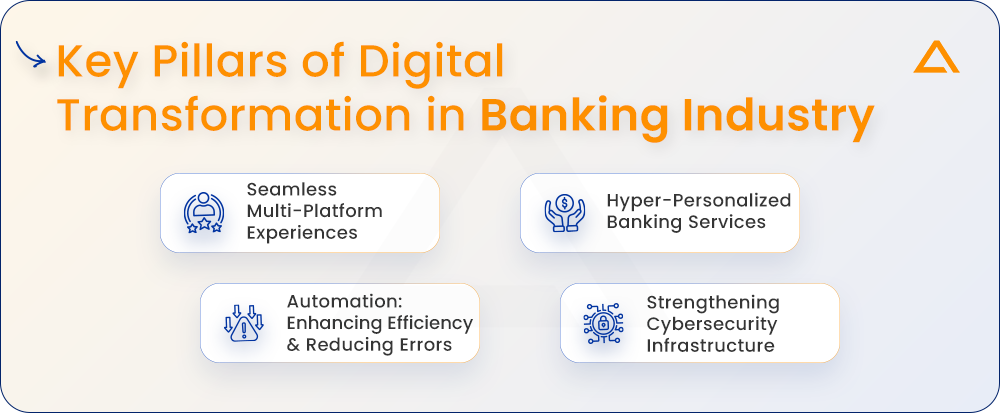
Seamless Multi-Platform Experiences (Omnichannel Banking)
Customers no longer rely on a single channel for their banking needs. They expect consistent, fluid experiences across apps, websites, ATMs, and even physical branches. A robust omnichannel strategy ensures that whether a customer starts a transaction on their smartphone and finishes it at a branch, the experience remains uninterrupted and personalized.
Omnichannel banking is a necessity, not a luxury. Customers who use multiple channels are more likely to be loyal to their bank, highlighting the importance of a seamless, integrated experience.
Hyper-Personalized Banking Services
The future of banking is all about personalization. Leveraging advanced data analytics, banks can anticipate customer needs and offer services tailored to individual preferences.
For instance, AI-driven insights can suggest investment opportunities based on spending habits or recommend personalized savings goals. Banks that excel in personalizing their offerings create deeper, more meaningful relationships with their clients, driving both retention and satisfaction.
Automation: Enhancing Efficiency and Reducing Errors
Automation has shifted from being a ‘nice-to-have’ to an essential tool for modern banks. Routine tasks like processing loan applications or answering customer inquiries are now handled by AI-powered systems, reducing errors and speeding up service delivery. This shift is a crucial part of bank digital transformation.
Strengthening Cybersecurity Infrastructure
With more services going digital, banks are prime targets for cyberattacks. Security has, therefore, become a top priority.
From biometric logins to AI-based threat detection systems, banks are using every tool at their disposal to protect customer data and prevent breaches. The focus is on multi-layered security, real-time monitoring, and using AI to predict and prevent threats before they happen.
Also Read: Benefits of Artificial Intelligence in Banking & Finance
Stats, Trends, and Popularity of Digital Transformation in Banking
The digital transformation in banking has revolutionized the industry, leading to significant growth and widespread adoption. Here are some key statistics, trends, and insights that highlight its impact:

Increasing Digital Adoption
- The number of active online banking users were reported to be 1903.2 million, with prediction to reach 1 billion by 2024 with Asian market being the largest. (Statista)
- The number of digital banking users in the US is expected to grow YoY reaching 217 million mark by 2025 as per Learn G2.
Financial Performance and Investment
Digital maturity has shown a direct link to superior financial performance based on seven digital pivots described by Deloitte as:
- Flexible, secure, infrastructure
- Data Mastery
- Digital savvy, open talent networks
- Ecosystem Engagement
- Intelligent workflows
- Unified customer experience
- Business model adaptability
Customer Preferences
93% of millennials say they prefer to manage their banking from one place, followed by Gen X (90%), GenZ (89%) and Boomers (84%). (Chase Media Center).
Technological Tools Leading the Banking Revolution
Several key technological tools are driving digital transformation in the banking industry. Let’s dive deeper into unveiling some of the most prominent ones:
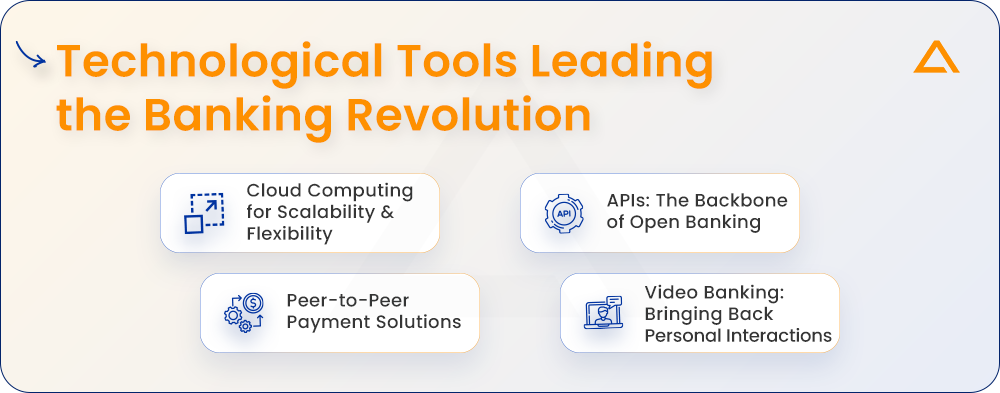
Cloud Computing for Scalability and Flexibility
Banks are moving critical operations to the cloud, allowing them to scale faster and reduce operational costs. Cloud computing not only makes it easier for banks to handle growing transaction volumes but also enhances collaboration between departments, especially in large, global organizations. The ability to scale infrastructure up or down as needed also allows banks to remain agile in a fast-changing industry.
For example, HSBC adopted cloud technologies to modernize its global infrastructure, resulting in a more flexible and cost-effective digital environment.
APIs: The Backbone of Open Banking
Application Programming Interfaces (APIs) are the connectors that allow banks to integrate with external services, enabling Open Banking. Customers are able to manage accounts from multiple banks using one app or by using third-party services like budgeting tools by establishing properly secure APIs.
Open Banking fosters innovation, allowing fintech companies to create new services while giving customers more control over their financial data.
Peer-to-Peer (P2P) Payment Solutions
The rise of P2P payment systems has revolutionized how we manage daily financial transactions. Gone are the days when sending money between individuals required a lengthy process.
Today, P2P platforms enable fast, simple, and often free transfers between users, redefining customer expectations for convenience in banking.
Video Banking: Bringing Back Personal Interactions
In a world that’s increasingly digital, video banking offers a way to maintain personal relationships with customers.
Whether for loan consultations or resolving complex queries, video collaboration tools help banks maintain a human touch without requiring in-person visits. It’s a key tool in blending technology with customer care, providing personalized service while remaining efficient.
Creating a Roadmap for Digital Transformation in Banking
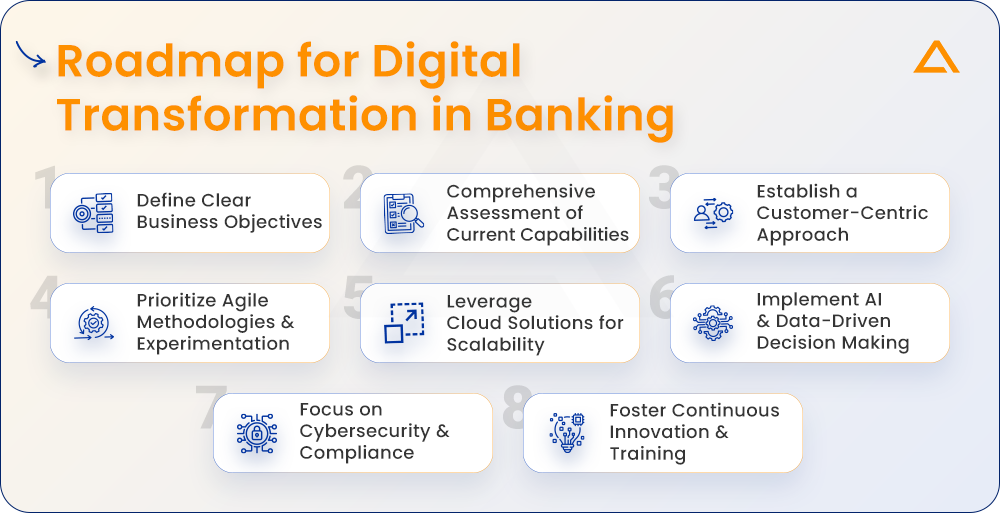
1. Define Clear Business Objectives Aligned with Digital Goals
Before diving into technology solutions, banks need to clearly define their business objectives. These could range from enhancing customer experience, streamlining operations, or tapping into new revenue streams.
Objectives must align with the broader digital transformation strategy, ensuring that each digital initiative directly supports the bank’s core mission.
For example:
- Enhancing customer experience through mobile banking features, chatbot integration, and improved response times.
- Cost optimization by automating back-office processes like compliance checks and reducing manual intervention in customer queries.
2. Comprehensive Assessment of Current Capabilities
Banks need to take stock of their existing infrastructure, operational processes, and talent. Conducting a thorough audit will reveal areas that need improvement, as well as which systems can be modernized or integrated into new technologies. This assessment includes:
- Technology stack: Are current systems scalable and compatible with modern applications?
- Cultural readiness: Is the workforce open to adopting new digital tools and methodologies?
- Customer needs analysis: What features are customers looking for in a digital banking experience?
3. Establish a Customer-Centric Approach
A successful digital transformation hinges on understanding the customer journey. Banks must map out every touchpoint—whether physical or digital—and identify where technology can enhance the experience. This includes:
- Personalized experiences: Leveraging AI and data analytics to offer tailored services.
- Omnichannel strategies: Ensuring seamless transitions across devices and platforms, from mobile apps to in-person interactions.
4. Prioritize Agile Methodologies and Experimentation
Traditional banking models are often rigid, making it difficult to implement new technologies quickly. Embracing agile methodologies can significantly speed up digital transformation, enabling banks to pilot new ideas, test digital products, and rapidly iterate based on feedback.
- DevOps frameworks: By adopting a DevOps culture, banks can deploy changes faster and more efficiently.
- Pilot programs: Banks should start small with digital projects and scale up once they’ve demonstrated tangible benefits, such as launching a mobile wallet in a specific region before rolling it out company-wide.
5. Leverage Cloud Solutions for Scalability
Migrating core banking operations to the cloud offers a bank greater flexibility, scalability, and cost savings. This shift enables faster data processing, secure storage, and reduced downtime. Cloud infrastructure allows for the seamless integration of new tools, such as AI-driven services, without disrupting legacy systems.
For instance:
- ING Bank uses cloud solutions to rapidly scale services and launch new digital banking features across multiple regions with reduced costs.
6. Implement AI and Data-Driven Decision Making
AI is transforming how banks operate, from automating loan approval processes to providing customers with real-time insights into their finances. Implementing AI and machine learning tools can help predict customer behaviors, reduce fraud, and improve decision-making accuracy. To make the most of AI:
- Data lakes: Create centralized data repositories that enable advanced analytics.
- Predictive modeling: Use historical customer data to predict trends and optimize banking products accordingly.
- Example: HSBC uses AI to analyze customer data and identify patterns for enhanced fraud detection, ensuring greater security for digital transactions.
7. Focus on Cybersecurity and Compliance
Digital transformation naturally exposes banks to heightened cybersecurity risks. As banks shift to digital platforms, it’s essential to invest in robust cybersecurity frameworks. The roadmap should include steps to secure digital infrastructure, protect customer data, and stay compliant with regulatory standards. Key actions include:
- AI-driven threat detection: AI systems that monitor and detect anomalies in real time.
- Biometric authentication: Implementing advanced security measures, like fingerprint or facial recognition, to enhance customer trust.
8. Foster Continuous Innovation and Training
Banks must foster a culture of continuous innovation by encouraging employees to embrace digital technologies and providing regular training programs. Investing in employee upskilling will help create a workforce that is adaptive and capable of leveraging the latest digital tools.
- Internal innovation labs: These can be set up to test new technologies in a controlled environment before integrating them into the bank’s core systems.

Looking for Digital Transformation Services?
Unlock your business’s full potential with Aglowid’s digital transformation services—drive unprecedented growth, maximize efficiency, and gain a powerful competitive edge.
Challenges Along the Digital Transformation Journey
Digital transformation in banking comes with significant challenges that can hinder progress. Banks must navigate internal and external obstacles, necessitating robust strategies to overcome them. Here are the most pressing challenges to look out for on your banking digital transformation journey.

Cybersecurity at Scale
The more data banks gather, the bigger a target they become for cybercriminals. Securing vast quantities of sensitive information across various platforms while staying compliant with ever-changing regulations is one of the biggest hurdles.
Legacy Systems: The Achilles Heel of Innovation
Many banks still operate on decades-old technology, which hinders their ability to roll out modern digital solutions. Transitioning away from these legacy systems to more agile cloud platforms is critical, yet it requires careful planning to avoid operational disruptions.
Compliance and Regulation
The banking industry is highly regulated, and digital transformation must always stay within the bounds of compliance. Ensuring data privacy, managing risk, and meeting new regulatory demands are ongoing challenges that banks must navigate carefully during their digital evolution.
The Role of Artificial Intelligence in Banking
Artificial Intelligence (AI) has become a game-changer in the banking industry. From chatbots handling customer inquiries to AI-powered systems detecting fraud in real-time, banks are leveraging AI to streamline operations and enhance security. AI is also being used in areas like credit scoring, risk assessment, and even investment advice, making banking services smarter, faster, and more accessible.
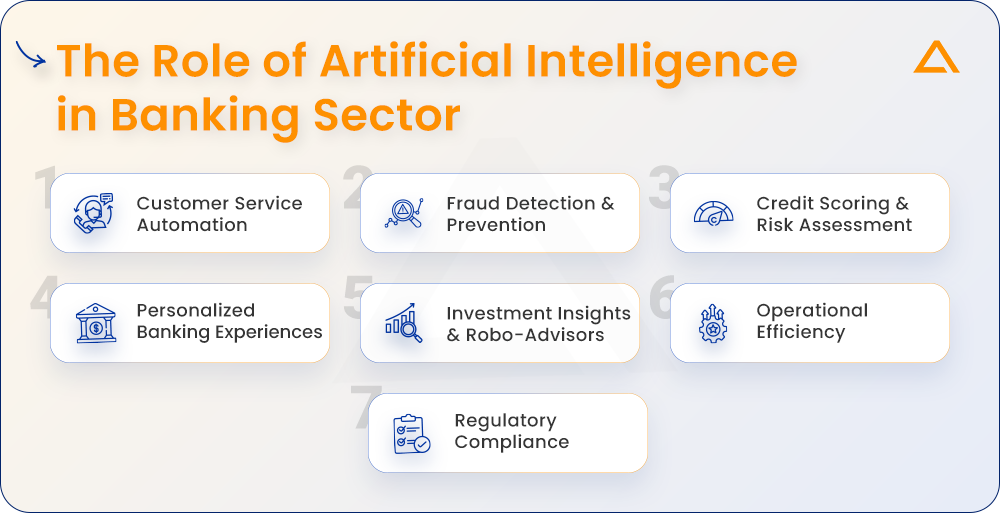
1. Customer Service Automation
AI-powered chatbots and virtual assistants are revolutionizing customer service. They can handle inquiries 24/7, providing instant responses to frequently asked questions, guiding customers through processes, and even assisting in transaction management. This reduces wait times and allows human agents to focus on more complex issues.
2. Fraud Detection and Prevention
Fraud remains a critical concern for banks, especially as they transition to digital services. AI algorithms analyze vast amounts of transactional data in real-time, identifying unusual patterns that may indicate fraudulent activities. These systems can flag potential fraud before it occurs, minimizing losses and protecting customers.
The continuous learning capabilities of AI ensure that these algorithms become increasingly accurate, staying ahead of evolving cyber threats.
3. Credit Scoring and Risk Assessment
AI is redefining how banks assess creditworthiness. Traditional credit scoring methods can be slow and often overlook valuable data points. AI models can analyze a broader range of data, including transaction histories and social media behavior, leading to more accurate assessments of an individual’s credit risk.
This not only enhances the lending process but also enables banks to serve previously underserved segments of the population, broadening their customer base.
4. Personalized Banking Experiences
AI enables banks to offer hyper-personalized services by analyzing customer behavior and preferences. By leveraging customer data, banks can tailor product recommendations, marketing strategies, and communication styles to match individual needs.
For example, an AI system might suggest specific investment options based on a customer’s spending habits or financial goals, increasing engagement and loyalty.
5. Investment Insights and Robo-Advisors
AI-driven robo-advisors are making investment services more accessible. These platforms utilize algorithms to analyze market trends, economic indicators, and individual client preferences to provide tailored investment advice.
This democratizes investment opportunities, allowing even small investors to access high-quality financial advice traditionally reserved for wealthier clients.
6. Operational Efficiency
AI helps banks streamline their operations by automating routine tasks such as data entry, document verification, and compliance monitoring. This not only reduces human error but also accelerates processes, leading to significant cost savings.
7. Regulatory Compliance
AI tools can assist banks in navigating the complex regulatory landscape. By automating compliance checks and monitoring transactions for regulatory adherence, banks can reduce the risk of penalties and enhance their compliance efforts.
AI systems can analyze vast amounts of regulatory data, ensuring that banks stay updated on changing requirements and maintain a strong compliance posture.
Conclusion: A Future-Ready Bank
Digital transformation in banking is not a one-size-fits-all process. It requires careful planning, agility, and a strong focus on customer needs. By embracing emerging technologies like AI, automation, cloud computing, and cybersecurity innovations, banks can not only stay competitive but also provide meaningful, value-driven experiences to their customers.
The future of banking is undoubtedly digital, and those who navigate this transformation effectively will set themselves apart in a rapidly changing financial landscape.
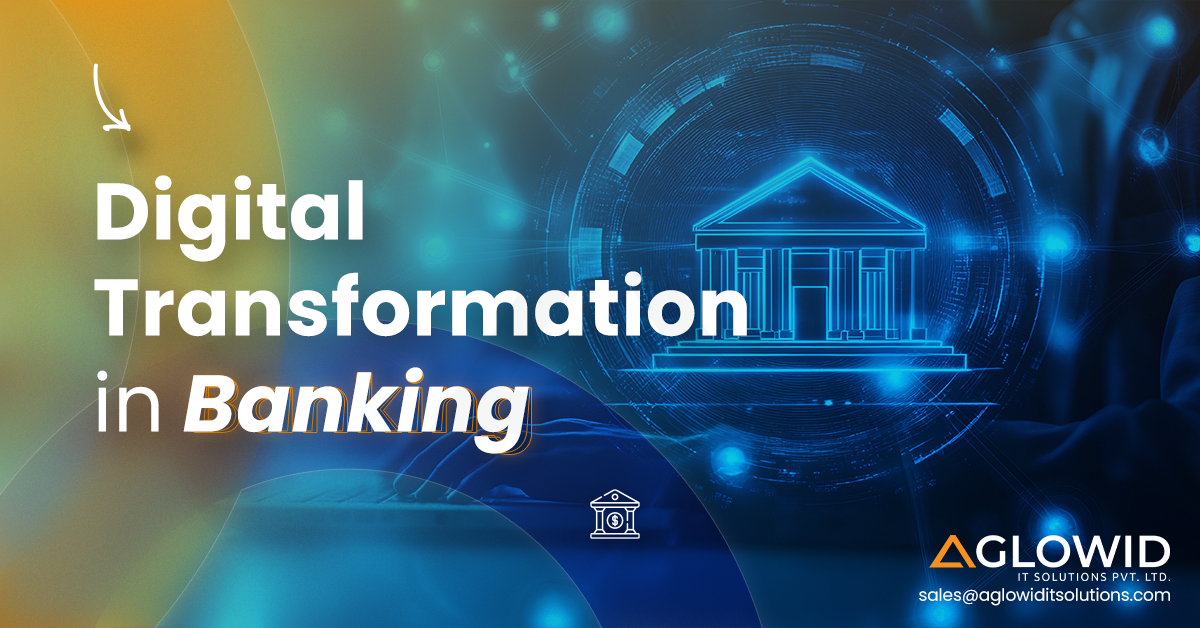

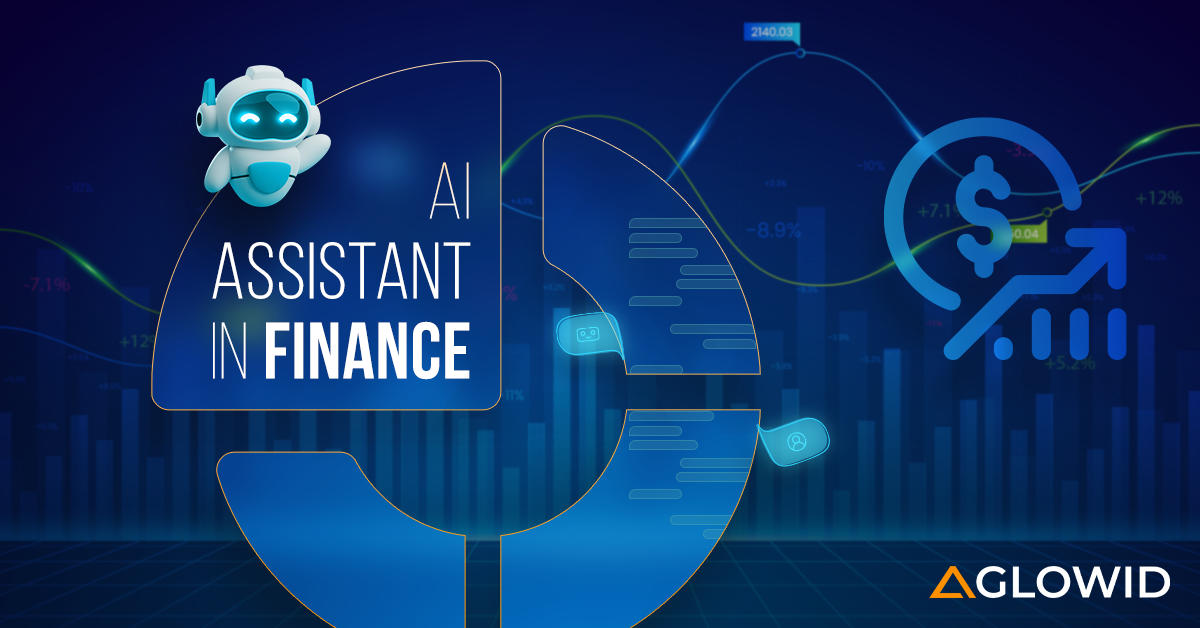


 Say
Say